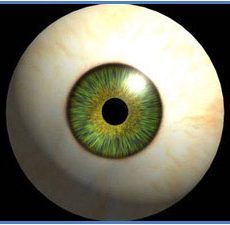
Visual vocabulary
San Cristóbal: (0276) 343-7209 | Caracas: (0212) 576-4038 | Ciudad de México: +52-55-5574-9398 | Puebla: +52-222-290-7591

Keratoconus (from Greek kerato = cornea, and cone = shaped cone), is a condition in which the cornea (front transparent lens of the eye), is abnormally thin and protrudes forward. Keratoconus means a cone shaped cornea.
What symptoms occur in keratoconus?
The initial symptom is blurred vision and can initially be treated with glasses, although the patient will notice progressively impaired visual capacity required changes in optical correction. Usually the progression is asymmetric, one eye may be worse faster than the other.
Some may have symptoms of hypersensitivity to light, fatigue when reading, or itchy eyes. Early symptoms of blurred vision may occur between 10 and 15 years, often progress slowly for 10 or 20 years. In some patients, the cornea bulges and thins, becoming irregular and sometimes forming scars.
This thinning and deformation of the cornea causes an increasingly high astigmatism that can not be treated by glasses and is necessary to test special contact lenses. The progression of keratoconus is usually slow and can stop at any stage, from mild to severe.
What causes Keratoconus?
Any factor that predisposes directly to the presence of keratoconus, about 7% of patients have relatives with keratoconus, but the cause is unknown, apparently is a degenerative condition, however Dra. Carmen Barraquer insists that the continuous rubbing eye is a factor that worsens keratoconus. For this reason it is important to rule out and treat allergic conjunctivitis with eye drops to avoid the feeling of itching or itchy eyes.
Keratoconus is not considered a hereditary disease. This disease occurs in approximately 1 in 2,000 individuals.
The actual incidence of keratoconus is not known, usually occurs in young people and is found in all parts of the world without following any geographical, cultural or social pattern.
What is the treatment of keratoconus?
The initial treatment is based on glasses fitting and if the patient tolerates it will try to adapt adequately special contact lenses for corneal curvature of each patient.
If alteration of the corneal curvature progresses and is no longer possible adaptation of contact lenses it is necessary to raise the corneal transplant surgery. Other surgical options include intracorneal rings (in USA: Intacs, in Brazil: Ferrara rings or Keraring) and corneal transplants lamellar guided by excimer laser.
It is important to remind all patients enrolled with KERATOCONUS that it is important NOT rub eyes, helping to avoid progress.
In approximately 10% of cases of corneal transplantation is required. Usually surgery is proposed when vision with contact lenses is not good enough or if become not tolerant to contact lenses.
By: Dr. Beatriz Antzoulatos.